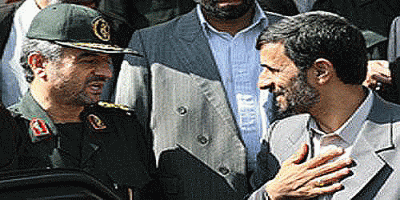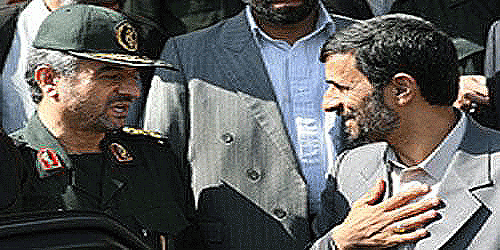 (Pictured: President Ahmadinejad and Revolutionary Guard Chief of Staff Mohammed Ali Jafari in happier times.)
(Pictured: President Ahmadinejad and Revolutionary Guard Chief of Staff Mohammed Ali Jafari in happier times.)
We’re honored to have Michael Busch dissecting the latest WikiLeaks document dump for Focal Points. This is the twenty-seventh in the series.
Of all the bizarre and intriguing information collected by US intelligence and revealed by the recent dump of WikiLeaked cables, none has been as surprising as a cable published on Jan. 3 by the German newspaper Der Spiegel. The dispatch, written this past February, relates details of a meeting amongst Iran’s Supreme National Security Council. The council met to discuss next steps in dealing with an Iranian population still reeling from state repression from the previous summer when citizens took to the streets to protest an obviously corrupted election.
Ahmadinejad, not exactly known for his open-minded disposition,
surprised other SNSC members by taking a surprisingly liberal posture during a mid January post-Ashura meeting of the SNSC called to discuss next steps on dealing with opposition protests. Source said that Ahmedinejad claimed that “people feel suffocated,” and mused that to defuse the situation it may be necessary to allow more personal and social freedoms, including more freedom of the press.
The suggestion didn’t go over so well with those in attendance.
According to source, Ahmedinejad’s statements infuriated Revolutionary Guard Chief of Staff Mohammed Ali Jafari, who exclaimed “You are wrong! (In fact) it is YOU who created this mess! And now you say give more freedom to the press?!”
In a flash of fury,
Jafarli then slapped Ahmedinejad in the face, causing an uproar and an immediate call for a break in the meeting, which was never resumed. Source said that SNSC did not meet again for another two weeks, after Ayatollah Janati succesfully acted as a “peacemaker” between Jafarli and Ahmedinejad.
While peace in the short-term may have been achieved between the two leaders, the cable goes on to report that
both sides are digging in for new confrontations, while various sub-groups maneuver. He stressed the importance of recent speeches by Karroubi and Khatami to the effect that Ahmedinejad will not be able finish his term, and that Supreme Leaders should not take partisan political sides. He stressed that “Karroubi chooses each word carefully,” and said the recent speeches reflect an ongoing effort to split Khameini from the Ahmedinejad group. Source described the overall political situation within and without the political elite as “getting worse and worse.” xxxxx opined that this situation (of protests and instability) cannot be sustained indefinitely, and predicted that events are trending towards major developments and a new phases. Asked what Iran will likely look like over the next year, he responded “ask me after 22 Bahman (February 11).”
As that draws near, Iranian politics continues to experience turbulence. Recent weeks have witnessed major reshufflings in Ahmadinejad’s inner circle. After the Iranian parliament jettisoned the president from the governing board of Iran’s central bank, Ahmadinejad has purged key members from positions of authority throughout his government. The highest-profile sacking was that of Foreign Minister Manouchehr Mottaki, but in a more sweeping move on Jan. 2, Ahmadinejad fired fourteen of his most senior advisors from their posts. It isn’t immediately clear whether the move was political in nature or not, but according to the Times of India, the “dismissals appeared to signal a rift at the top levels of the Iranian leadership, pitting the president against rival conservatives.”
